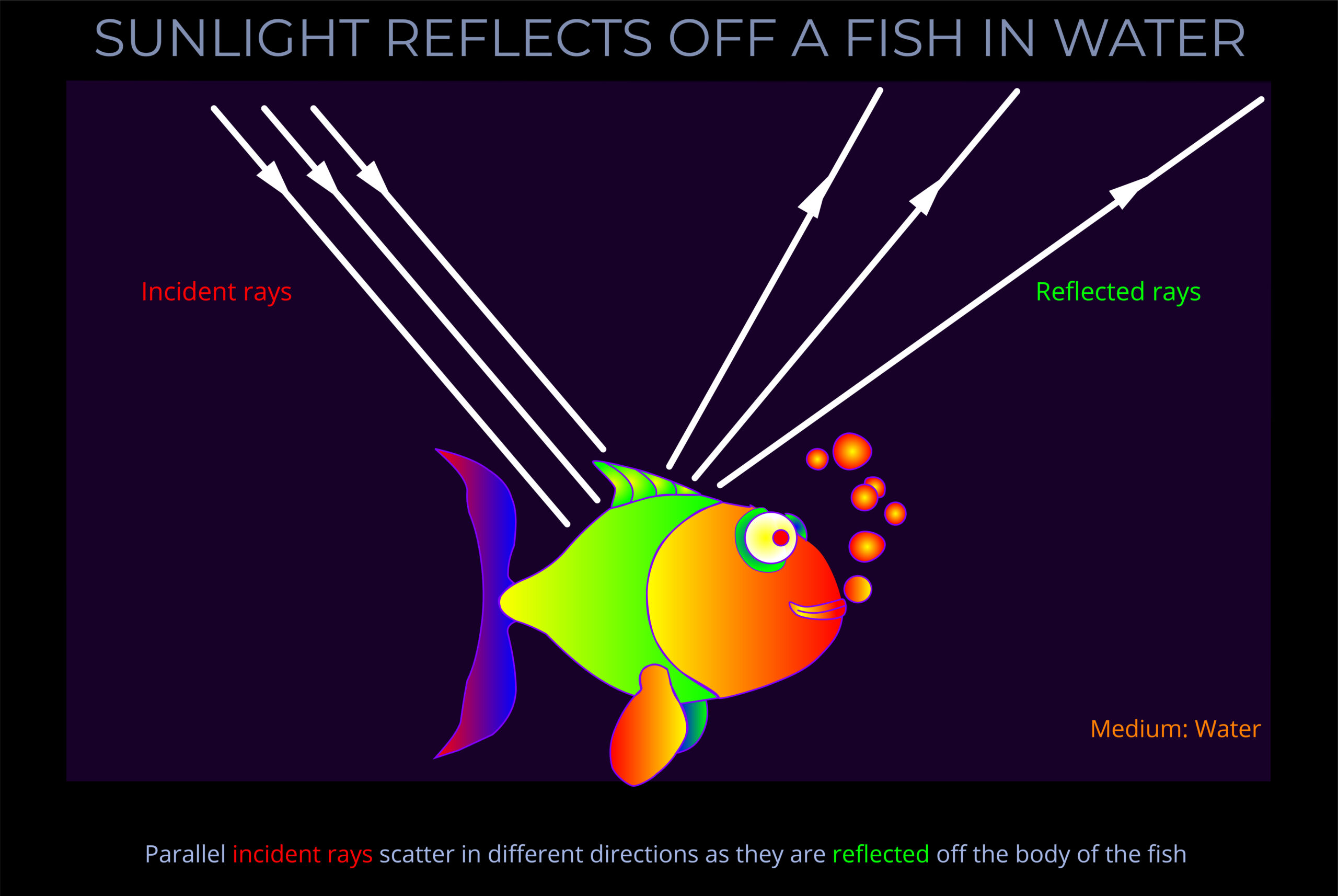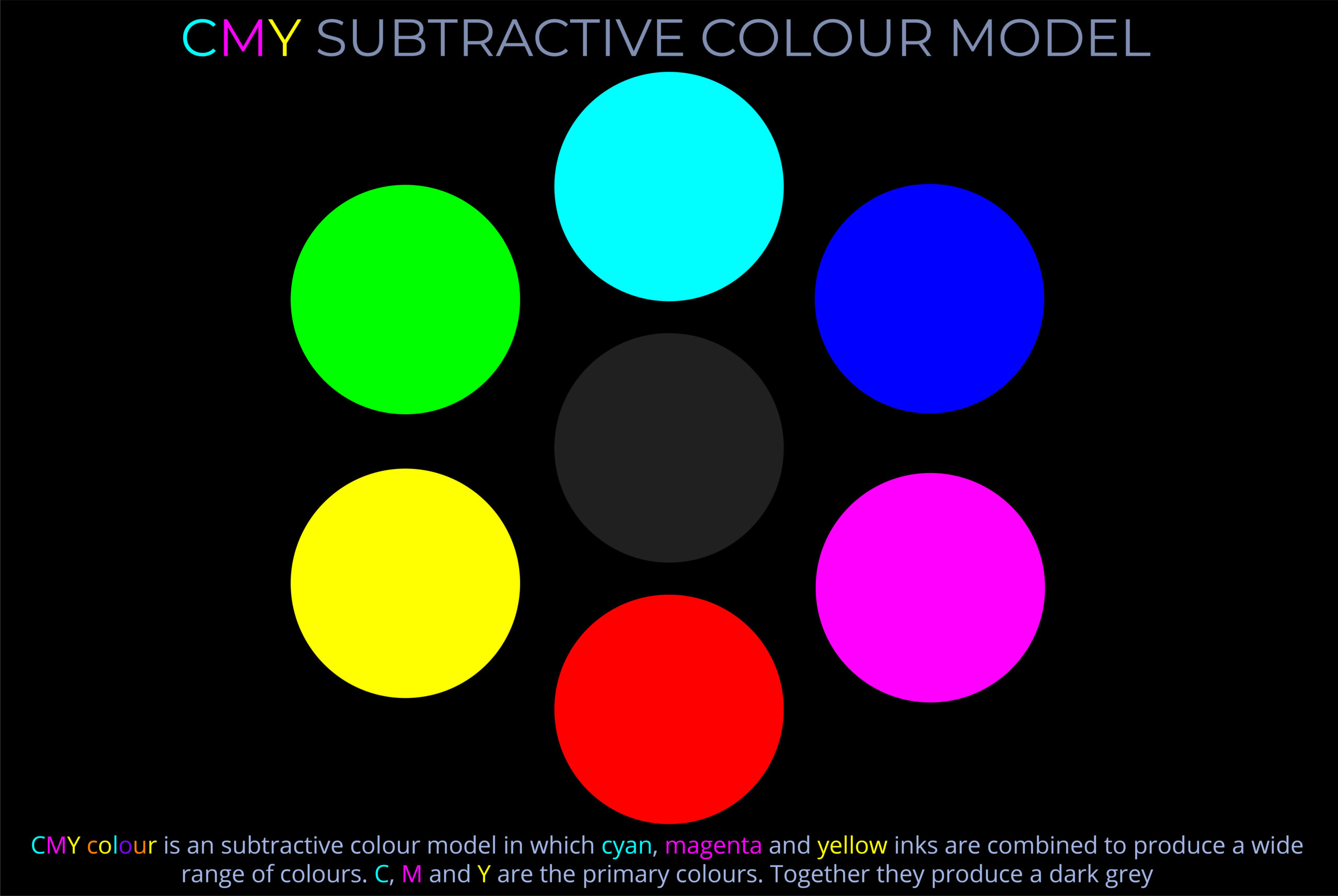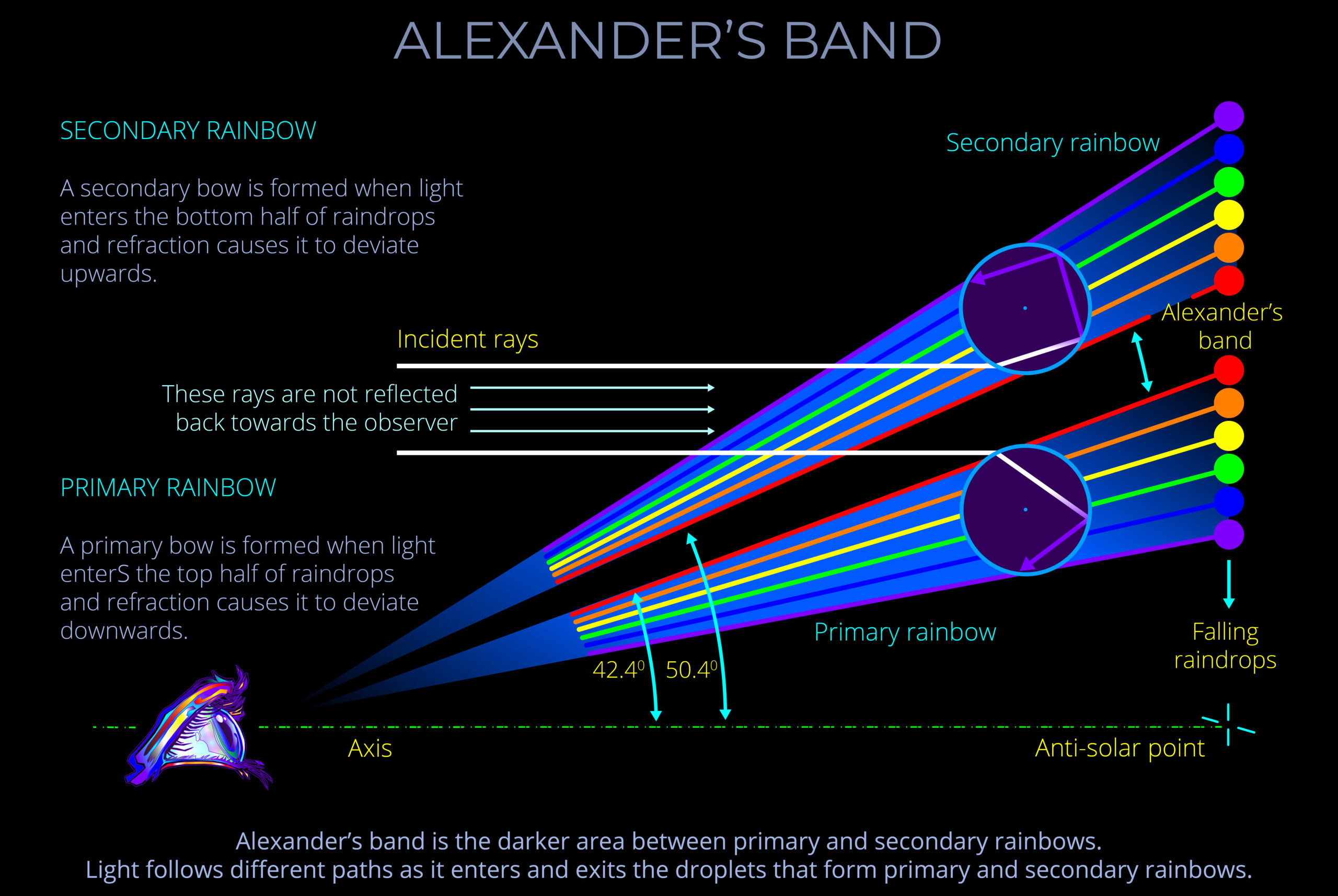An important optical effect that explains how raindrops produce rainbows is refraction.
Refraction refers to the way that electromagnetic radiation (light) changes speed and direction as it travels across the interface between one transparent medium and another.
- As light travels from a fast medium such as air to a slow medium such as water it bends toward the normal and slows down.
- As light passes from a slower medium such as water to a faster medium such as air it bends away from the normal and speeds up.
- In a diagram illustrating optical phenomena like refraction or reflection in a raindrop, the normal is a line drawn from the surface of a raindrop to its centre.
- The speed at which light travels through a given medium is expressed by its refractive index (also called the index of refraction).
- If we want to know in which direction light will bend at the boundary between transparent media we need to know:
- Which is the faster, less optically dense (rare) medium with the smaller refractive index.
- Which is the slower, more optically dense medium with the higher refractive index.
- The degree to which refraction causes light to change direction is dealt with by Snell’s law.
- Snell’s law considers the relationship between the angle of incidence, the angle of refraction and the refractive indices (plural of index) of the media on both sides of the boundary. If three of the four variables are known, then Snell’s law can calculate the fourth.
More about refraction in a raindrop
- Light rays (streams of photons) undergo refraction twice when they encounter a raindrop, once as they enter, then again as they leave.
- Once inside a raindrop, a given photon may reflect off the inside surface of a raindrop several times, but on each refraction, some light crosses the boundary back and undergoes refraction as it escapes into the surrounding air.
- Some photons never escape, instead, they are absorbed when they strike electrons within a raindrop, releasing heat that can causes evaporation.
Saturation refers to the perceived difference between one colour and another in terms of its purity and vividness.
- A fully saturated colour appears bright and vibrant because it has a single strong dominant hue.
- A freshly cut tomato is a good example of a saturated colour with a strong red hue.
- A saturated colour is a unique spectral colour produced by a single wavelength (or a narrow band of wavelengths) of light.
- A fully saturated colour (100%) is the purest version of a hue.
- Unsaturated colours (0-10%) can appear:
- Misty or milky the nearer they are to white.
- Dull and washed out as their hue disappears leaving achromatic grey tones.
- The hue of a vivid colour appears to be at full strength and can leave an after-image of its complementary colour as an observer looks away.
Scattering occurs when light waves interact with particles or irregularities within a medium, causing the light to change direction. This can happen when light encounters obstacles such as atmospheric molecules, dust particles, or surface imperfections.
- Scattering happens when individual photons or light waves are deflected in different directions, depending on the medium’s composition, particle size, and surface properties.
- Scattering contributes to various natural phenomena, such as the sky’s blue colour, the whiteness of clouds, and the shimmering of water surfaces.
- Scattering differs from other optical phenomena:
- Reflection: Light bounces back, as in a mirror.
- Refraction: Light is bent as it passes through different materials.
- Diffraction: Light spreads out after encountering an obstacle.
- Absorption: Light is absorbed by the material and not re-emitted.Scattering differs from other optical phenomena.
- Scattering can be effectively subdivided into regular scattering and random scattering, each characterized by distinct mechanisms and patterns of light interaction.
Scattering takes place when streams of photons (or waves of light) are deflected in different directions. In this resource, the term is used to refer to the different forms of deviation produced by diffusion, dispersion, interference patterns, reflection and refraction as well as by the composition and surface properties of different media.
Regular scattering
- When light of a particular wavelength strikes the surface and enters a raindrop its subsequent path depends upon the point of impact, the refractive indices of air and water and the surface properties of the droplet.
- For incident rays of a single wavelength striking the surface of a single droplet at different points, it is the different angles at which they enter the droplet that are the chief determinant of the way they scatter as they exit the droplet. In this case.
- For incident rays of white light striking the surface of a single droplet at different points, it is the combined effects of the different angles at which they enter the droplet along with the effects of chromatic dispersion (causing the separation of white light into spectral colours) that determine the form of scattering.
- Chromatic dispersion refers to the way that light, under certain conditions, separates into its component wavelengths and the colours corresponding with each wavelength become visible to a human observer.
- Regular scattering is not random and obeys the law of reflection and refraction (Snell’s law).
Random scattering
- In optics, diffusion results from any material that scatters light during transmission or reflection producing softened effects without sharp detail.
- Objects produce diffuse reflections when light bounces off a rough or uneven surface and scatters in all directions.
- Transparent and translucent materials transmit diffuse light unless their surfaces are perfectly flat and their interiors are free of foreign material.
- All objects obey the law of reflection on a microscopic level, but if the irregularities on the surface of an object are larger than the wavelength of light, the light undergoes diffusion.
- A reflection that is free of the effects of diffusion is called a specular reflection.
- In the case of raindrops, random scattering can result from:
- Atmospheric conditions affecting incident sunlight.
- Turbulence distorting the shape of raindrops.
- Light being reflected off the surface of multiple raindrops, one after another, before reaching an observer.
A scotopic curve is a graphical representation of the sensitivity of the human eye to light under low-light conditions, such as at night or in very dimly lit environments.
- The scotopic curve resembles a line graph that shows how sensitive the human eye is to light in these low-light conditions. It is an important tool for understanding night vision. The curve illustrates the minimum amount of light needed for the eye to detect different wavelengths (colours) of light.
- This information is derived from the response of our rod cells, which are more active in low light compared to the cone cells that dominate in bright conditions.
- Closely related to the scotopic curve is the photopic curve, which represents the sensitivity of the human eye to different wavelengths of light under well-lit conditions. While the scotopic curve peaks at around 498 nanometers (blue-green light), indicating that our eyes are most sensitive to these wavelengths in low light, the photopic curve peaks at around 555 nanometers (green-yellow light) under bright conditions.
- It is interesting to note that the scotopic and photopic curves use different units to measure light. The scotopic curve uses units related to light intensity per unit area (such as brightness per square degree), whereas the photopic curve uses units similar to overall brightness.
A secondary colour is created by mixing two primary colours in equal parts. The primary colours may belong to either an additive colour model, which combines wavelengths of light, or a subtractive colour model, which mixes pigments or dyes.
- In additive colour models such as the RGB colour model, which deals with the effects of mixing coloured light, a secondary colour results from overlapping the primary colours: red, green, and blue. The secondary colours produced by combining pairs of primary colours in the RGB model are cyan, magenta, and yellow.
- In subtractive colour models such as the CMY colour model, which is concerned with mixing dyes and inks, a secondary colour results from overlapping the primary colours: cyan, magenta, and yellow. The secondary colours produced by combining pairs of primary colours in the CMY model are red, green, and blue.
A secondary rainbow appears when sunlight is refracted as it enters raindrops, reflects twice off the inside surface, is refracted again as it escapes back into the air, and then travels towards an observer.
- A secondary rainbow always appears alongside a primary rainbow and forms a larger arc with the colours reversed.
- A secondary rainbow has violet on the outside and red on the inside of the bow.
- When both primary and secondary bows are visible they are often referred to as a double rainbow.
- A secondary rainbow forms at an angle of between approx. 50.40 to 53.40 to its centre as seen from the point of view of the observer.
- A secondary bow is never as bright as a primary bow because:
- Light is lost during the second reflection as a proportion escapes through the surface back into the air.
- A secondary bow is broader than a primary bow because the second reflection allows dispersing wavelengths to spread more widely.
Remember that:
- The axis of a rainbow is an imaginary line passing through the light source, the eyes of an observer and the centre-point of the bow.
- The space between a primary and secondary rainbow is called Alexander’s band.



















